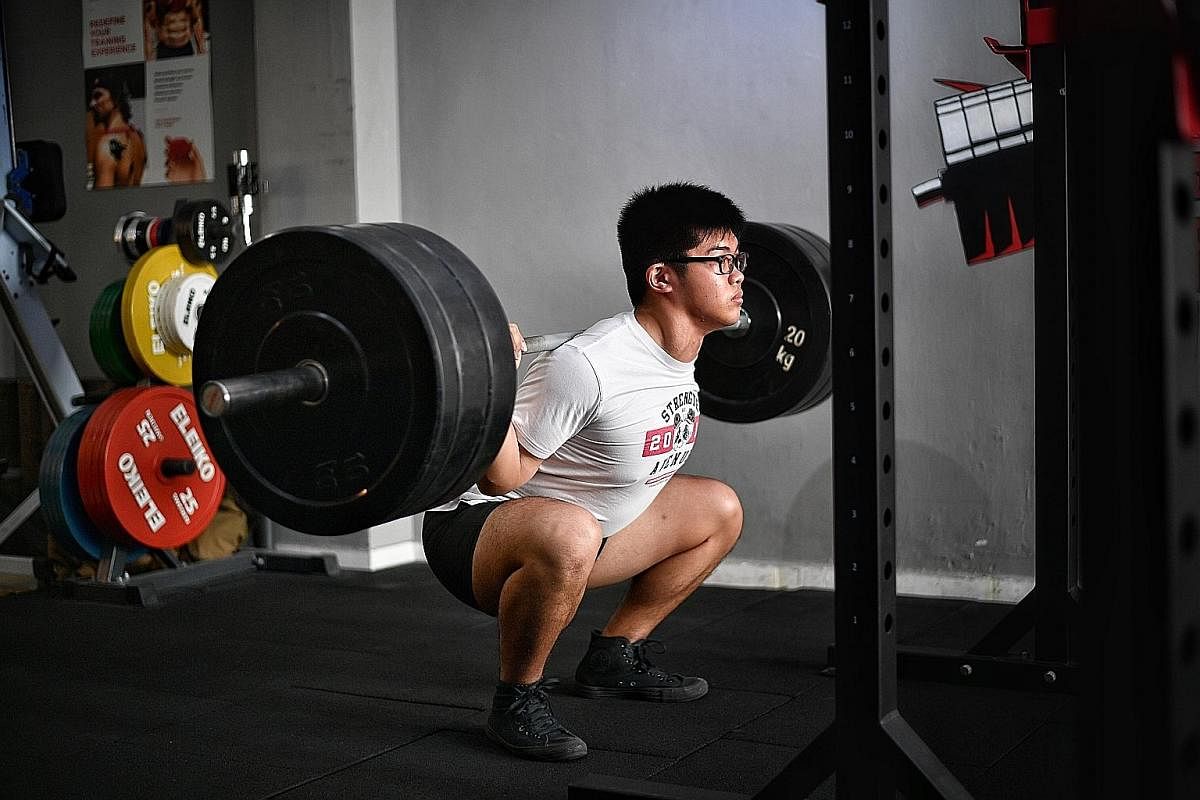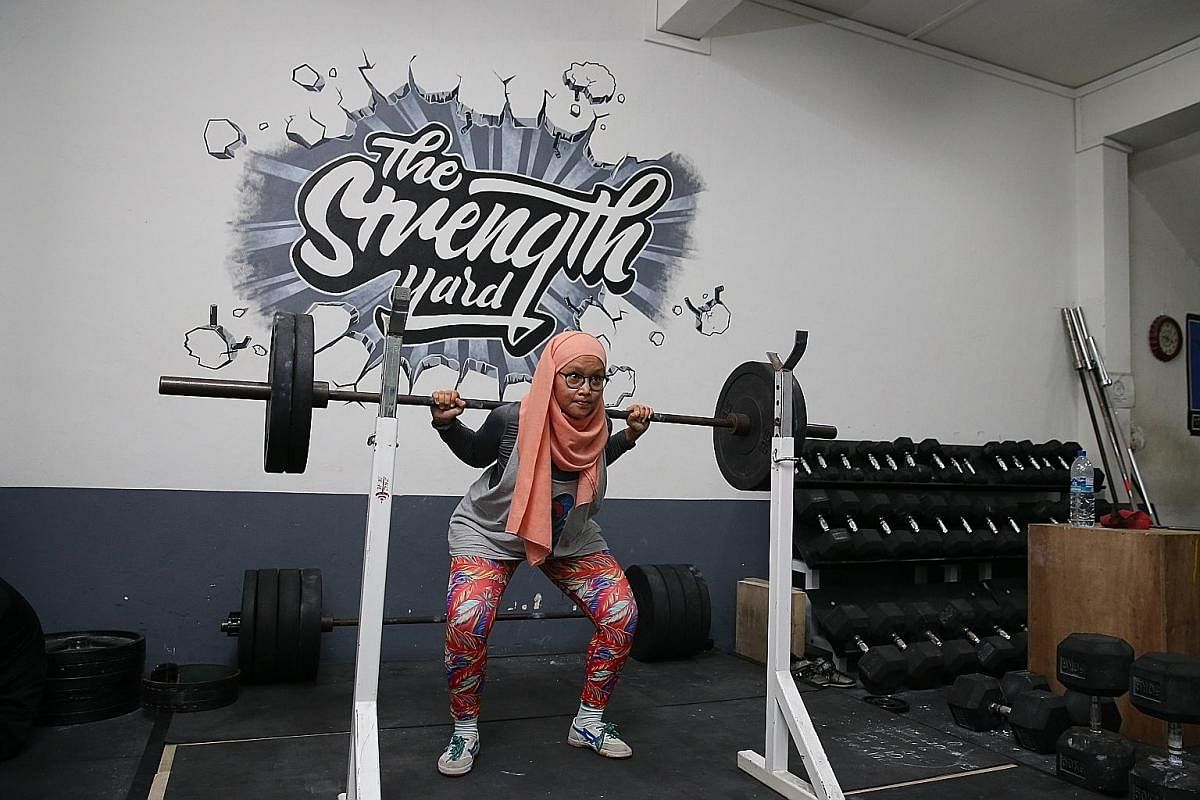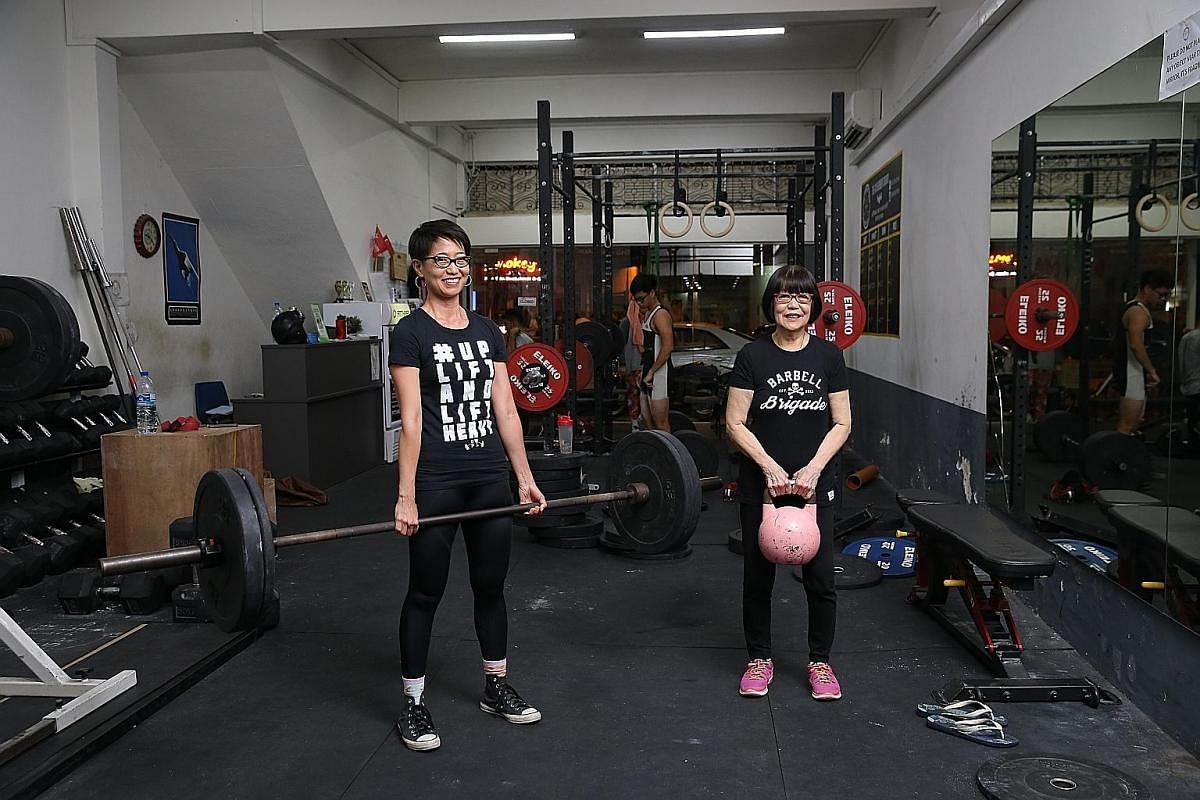Features
Teens and women take up powerlifting
Powerlifting, which comprises squats, benchpresses and deadlifts, muscles its way into the local fitness scene as more teenagers and women pick up the sport



The Strength Yard in Joo Chiat is busy at 8pm on a Friday night.
Inside the shophouse, people of different body types are tackling barbells loaded with weight plates. There are lanky teenagers, petite women and, of course, the obvious musclemen. The air is filled with grunts and the clanging of heavy metal hitting the ground.
Welcome to the powerlifting scene in Singapore, which embraces enthusiasts of all stripes, ages and sizes.
Powerlifting is a sport that consists of three exercises: squats, benchpresses and deadlifts. The goal is to lift as much weight as possible for each exercise. It is different from bodybuilding, which emphasises the pursuit of a sculpted, toned physique.
Despite how strenuous powerlifting can be, the sport has attracted the interest of enthusiasts, especially teenagers and women, say gym trainers and experienced powerlifters.
Powerlifting was recently in the spotlight when Singaporean teenager Matthew Yap, 18, broke the world squat record in the men's Under-66kg sub-junior division at the World Classic Powerlifting Championships in June. He hit 208kg on his final attempt in the event, held in Minsk, Belarus.
Ms Daphne Maia Loo, media officer at Powerlifting Singapore, which is linked to the International Powerlifting Federation (IPF), says its membership numbers have gone up. The IPF is the head of almost 100 country federations in powerlifting.
In 2012, Powerlifting Singapore had about 13 members. Today, it has about 400 actively competing athletes. The federation also holds competitions at least twice a year.
Ms Loo, 34, who is also a trainer at Strength Avenue, a strength and conditioning gym in Kampong Bahru Road, says: "We always see new faces at our meets, especially younger powerlifters who are between 16 and 18 years old.
"It's an easy sport to get into. All you need is to find a gym with weights and barbells and you can get started.
"There's a lot of room for the sport to grow. It hasn't even reached critical mass."
There are no gyms dedicated to powerlifting, but Ms Loo estimates there are about 20 "powerlifting-friendly" gyms that have sprung up.
Most ActiveSG Gyms - public community gyms in neighbourhoods here - would have the basic equipment such as barbells, weight plates and squat racks.
Interest groups such as the Singapore Powerlifting Alliance (SPA), which was started in 2013 by five Singapore Management University students who met in the school's gym, also helped to give the sport a leg-up.
While SPA does not offer memberships as it is a not-for-profit organisation, it holds competitive meets. When it held its first one-day meet at the university in 2013, 45 powerlifters turned up.
Last month, 96 people competed at the annual SPA Championships, including lifters from countries such as Indonesia, Thailand and India.
Lawyer Cheryl Ng, 28, who is one of the co-founders of SPA, says the sport has gained a strong following here, thanks to social media.
Instagram pictures and videos of powerlifters challenging themselves flood the photo-sharing app regularly.
There are also more websites dedicated to perfecting the art of powerlifting.
The powerlifting community is also welcoming. Experienced lifters often share tips at the gym with rookies.
Ms Ng is a classic example. Initially, she started going to the gym to shed kilograms and weight training was one of her exercises.
At first, she trained by herself, but gradually, she started to make friends with other regular lifters, whose help and advice encouraged her greatly.
She took the sport more seriously and found that it improved her self-esteem and confidence.
"I find that I am not limited by any barriers. I start to appreciate what my body is capable off."
Some powerlifters form informal training groups to motivate one another.
Take Victoria Junior College student Nicholas Canete, 17, for example. He started dabbling in weights four years ago when he was studying at Victoria School.
Together with former schoolmate Chen Kun, who now studies at Temasek Junior College, they started an informal powerlifting group about three years ago.
Today, the group has about seven active members, who train together whenever they can.
He says: "It motivates you when you train together. Your friends will hold you accountable to the goals you want to achieve."
But powerlifting, like any other solo sport, is ultimately about challenging one's physical limits.
When Nicholas started powerlifting seriously, he could deadlift 100kg. Today, that number has gone up to 240kg - almost triple his weight of 82kg.
"It's such a 'shiok' feeling to see your numbers go up," he says. But you have to keep at it and fight for every bit."
Even as more people get into powerlifting, there are still niggling concerns about how heavy lifting affects the body, especially those of growing teenagers.
Common worries include stunted growth and lower-back and shoulder injuries.
Dr Bryan Tan, an orthopaedic surgeon from OrthoSports, a specialist clinic that deals with sports injuries and common orthopaedic problems, says there is a misconception that lifting heavy weights affects growth rates.
He points out that children are more likely to sustain injuries that potentially stunt their growth doing contact sports. He adds that powerlifting injuries happen because of a lack of supervision or inadequate training that results in poor technique.
"Lifting in general is recognised to be beneficial to young people for many reasons. They build strength, reduce chances of injury while participating in other sports, improve coordination and motor skills, increase bone mass and enhance growth and development," says Dr Tan.
The Strength Yard's co-founder Edmund Neo, 28, who taught himself to powerlift when he was at university, says injuries often happen when powerlifters forget the fundamentals of lifting as they start "chasing the numbers".
He says: "Anything taken to the extreme is bound to be bad for you. But powerlifting is a scalable sport.
"You start young and build on a strong foundation. It's all about controlled risk."
He only wanted to lose weight
When Mr Jasper Wong, 18, started hitting the gym with a friend early last year, his goal was to lose some weight and tone his body.
There, the Institute of Technical Education student was intrigued by the sight of young powerlifters doing squats, benchpresses and deadlifting with heavy loads and, out of curiosity, he decided to give the sport a shot.
With the help of those powerlifters, he squatted with 50kg of weights, which is impressive for a newbie.
This was the beginning of his powerlifting journey. The stocky teenager trains at Strength Avenue, a sports performance studio gym in Kampong Bahru Road. He is there at least three times a week, working out for a couple of hours after school.
In August last year, he stepped up to the mat and took part in his first competition. Then, he could squat with 140kg, benchpress 95kg and deadlift 180kg.
At last month's Singapore Powerlifting Alliance meet, he deadlifted 205kg of weights - his personal best.
He is ranked fourth in his under- 75kg weight class, according to Powerlifting Singapore, a local federation that is linked to the International Powerlifting Federation, the international governing body for the sport.
Mr Wong, who also does yoga to improve his flexibility and mobility, says: "I never thought I would do this competitively. It was already a huge achievement that I could lift. I see myself getting stronger as I train harder and that keeps me going."
He spent about $700 on essential gear such as a powerlifting singlet, knee sleeves, shoes and a belt. To pay for it, he works part-time as a banquet waiter.
He gets support from his parents too. His father, who is a taxi driver, and his housewife mother tell him to be careful and not push himself too hard.
Mr Wong, who has an older sister, says: "They tell me that I can always try again another day."
He has also made many friends through the sport, including meeting some through Instagram.
"Powerlifting has been a big change in my life. I'd rather come to the gym to train and improve my numbers than sit at home and play computer games."
Attire not a deterrent
The first time she saw videos of someone doing a powerlifting squat and deadlifting on Instagram in 2015, Ms Nurul Huda Izyan wanted to give the sport a try. But she was worried about what she would wear when she exercised.
From her online research, she could not find many other women who lifted weights wearing the hijab, or traditional Muslim head scarf.
When they compete, powerlifters also typically wear a singlet, which is a type of tight, sleeveless onesie, an outfit which is too revealing for her.
But eventually, the 28-year-old, who had boxed in a hijab before, stopped obsessing over her attire.
"I should just wear what I think is right and focus on lifting," says the assistant festival manager of the Singapore Writers Festival.
But there were other problems. Before she saw the powerlifting videos, she was already doing strength training at Celebrity Fitness about twice a week under the guidance of a male trainer.
He warned her that lifting weights would make her big and discouraged her from taking up the sport.
She was not afraid of bulking up, so she started working out at The Strength Yard in Joo Chiat instead, which offers powerlifting training.
Then, her parents started worrying. Her mother, a teacher, and her father, who does freelance work, said lifting heavy weights would hurt her back or affect her womb.
Ms Nurul said her parents eventually got used to the idea that their daughter was serious about the sport. She has two younger brothers who are not into powerlifting,
When she started, she aimed to lift weights of between 60 and 70kg, similar to her body weight.
Two years of training later, she can now bench 50kg, squat with 100kg and deadlift 120kg .
She has also taken part in two competitive meets - wearing a hijab and a long-sleeved shirt and tights under the competitive singlet.
At the first meet, she snagged a medal competing in the under- 67.5kg weight category.
"I took part to challenge and push myself, to see what limit I could reach. I wasn't expecting the medal at all."
The sport has also brought her love. She met her boyfriend, Mr Hafeez Zainal Abidin, a 27-year-old video editor, at a competitive meet last year.
A fellow powerlifter, he is her "motivator" who eggs her on when she is not in the mood to train - they often lift together.
Calling the gym her "sanity place", she says: "It's good to have someone who gets that I want to be there and encourages me to do better."
Cancer survivor can now deadlift 65kg
About two years after surviving ovarian cancer, Ms Melissa Ong found out last year that she had osteopenia - early signs of bone loss that can develop into osteoporosis. So, her doctor encouraged her to lift weights to build up her bone density.
At the time, she was "in denial" that she could have brittle bones. Although she used to rock-climb about 10 years ago and practises yoga occasionally, she "didn't want to be stuck within four walls. Also, the weights area is usually occupied by macho men, so it was a bit intimidating too".
Eventually, she hired a personal trainer who taught her basic lifting skills that included the squat, benchpress and deadlift - the three powerlifting moves.
Ms Ong, 45, a film-maker at A Rocha, a nature conservation non-profit organisation, says: "I was very weak after cancer. I had lost a lot of muscle... I was thin, but it was just body fat. Even going to the toilet took a lot of effort."
At the start, she could not even do a bodyweight squat, a move in which a person lowers himself by first placing his feet shoulder-width apart and hands behind the head. Just doing it terrified her.
"I could feel the hair on my neck and arms stand and I felt cold. I ended up crying, " says Ms Ong, who works out at the Sembawang outlet of Anytime Fitness, a 24-hour gym chain.
She stuck with the programme. As she got stronger, she eventually started training with a barbell and later added weights.
Today, the 51.7kg woman can deadlift 65kg.
Ms Ong, who is married and does not have children, says: "Powerlifting has changed the way I move. It has improved my posture and balance.
"Every time I lift weights, I feel a rush of endorphins and it has also improved my confidence."
Convinced of the benefits of exercising with weights, she bought gym memberships for her parents, who are in their 70s.
Her mother, Madam Minnie Lee, 73, was starting to fall down a lot and Ms Ong did not want her parents to get hip fractures.
Now, they work out at the gym, with the help of a personal trainer.
Madam Lee works out with kettlebells and the Smith machine - which consists of a barbell that is fixed within steel rails.
Her husband, who used to do bodybuilding, uses weight machines and can benchpress 40kg weights.
Madam Lee, who is a retired secretary, says: "At first, it was awkward because we were the oldest couple at the gym. But after doing it, I felt good."
Sharing the passion for working with weights, Ms Ong says: "The beauty of it is that anyone can do it."
Join ST's Telegram channel and get the latest breaking news delivered to you.
A version of this article appeared in the print edition of The Sunday Times on September 03, 2017, with the headline Teens and women take up powerlifting. Subscribe

